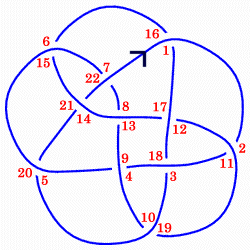Notation for knots
Notations are developed to describe diagrams of knots in a succinct but useful way. The ultimate goal is to encode the knot diagram in a way that enables someone else to reconstruct an equivalent diagram from the code.
Gauss Code
 The Gauss code for knot diagrams is perhaps the
easiest to describe. Suppose we have a diagram for some oriented
knot. Arbitrarily, pick a point P on the knot that is not on a
crossing. Then follow the orientation of the knot to arrive at the
first crossing, and label it 1. Then, follow the strand to the next
crossing. If the crossing you arrive at is not already labeled, then
label it 2 (i.e. one greater the crossing you last labeled). Else,
skip this crossing and proceed to the next one. Repeat this procedure
until all the crossings are labeled (once).
The Gauss code for knot diagrams is perhaps the
easiest to describe. Suppose we have a diagram for some oriented
knot. Arbitrarily, pick a point P on the knot that is not on a
crossing. Then follow the orientation of the knot to arrive at the
first crossing, and label it 1. Then, follow the strand to the next
crossing. If the crossing you arrive at is not already labeled, then
label it 2 (i.e. one greater the crossing you last labeled). Else,
skip this crossing and proceed to the next one. Repeat this procedure
until all the crossings are labeled (once).
Given this labeling of the crossings, the notation is derived by walking the knot again, starting at P. As we follow the knot, we record the crossings we encounter, keeping in mind that if we happen to traverse a crossing by an under-crossing strand, then we record the label of the crossing with a negative sign. The procedure terminates when you walk the whole knot.
For the example diagram, the Gauss code will be:
1 -2 3 -4 5 6 -7 -8 4 -9 2 -10 8 11 -6 -1 10 -3 9
-5 -11 7Extended Gauss Code
In general, the Gauss Code for some knot diagram cannot reconstruct an equivalent diagram, but a minor revision of the notation will make the reconstruction possible. The revision is called the Extended Gauss Code.
The crossings are labeled exactly as before. And, the crossings are recorded as before except that rules for assigning the signs are revised slightly. The first time we encounter a given crossing, we do as before--over-crossing is positive, under-crossing is negative. The second time we encounter a crossing, we assign a sign depending the handedness of the crossing. If it is right-handed, then we assign positive; if it is left-handed, negative.
Therefore, for the example, the Extended Gauss Code will be:
1 -2 3 -4 5 6 -7 -8 -4 -9
-2 -10 8 11 6 -1 -10 3 9 -5 -11 -7DT Notation
 The Dowker-Tait Notation (DT Notation) of a given knot diagram can be
found with a similar procedure of labeling the crossings.
The Dowker-Tait Notation (DT Notation) of a given knot diagram can be
found with a similar procedure of labeling the crossings.
Pick an arbitrary point P on the knot that is not on a crossing. Then follow the orientation of the knot to arrive at the first crossing, and label it 1. Proceed to the next crossing and label it 2. One might come across crossings that have been labeled already, but if this is the case, give it a second label. (You will never need to assign a third label, and eventually, every crossing will have two labels.)
One observes that each crossings has an even label and an odd label. The DT notation is derived by locating the odd labels in order (i.e. 1, 3, 5, etc...) and recording the corresponding even labels, the sign of which is determined by whether it was an over-crossing or an under-crossing strand that assigned the odd label. If the odd label was assigned by an under-crossing strand, we record the corresponding even label with a negative sign.
Given the labeling in the example, the DT notation is:
16 18 20 -22 4 2 8 -6 12 10 -14PD Notation
 To find the PD notation of a knot, as defined by Bar Natan, cut the knot at the crossing points and label the resulting arcs sequentially in the direction of the knot. At each crossing point, starting at the incoming under arc, travel around a small circle about the crossing point, in a counter-clockwise direction, and list the four arcs that are encountered. In the diagram at the right (borrowed from the Knot Atlas) at the first crossing the arcs in this order are 1, 9, 2, and 8. Thus, for this knot, the full PD notation would be
To find the PD notation of a knot, as defined by Bar Natan, cut the knot at the crossing points and label the resulting arcs sequentially in the direction of the knot. At each crossing point, starting at the incoming under arc, travel around a small circle about the crossing point, in a counter-clockwise direction, and list the four arcs that are encountered. In the diagram at the right (borrowed from the Knot Atlas) at the first crossing the arcs in this order are 1, 9, 2, and 8. Thus, for this knot, the full PD notation would be[[1,9,2,8],[5,3,6,2],[3,10,4,11],[9,4,10,5],[5,3,6,2],[11,7,12,6],[7,1,8,12]]